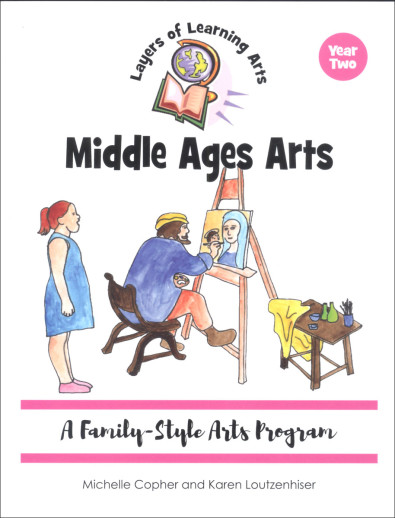We use cookies to make your experience better. To comply with the new e-Privacy directive, we need to ask for your consent to set the cookies. Learn more.
Middle Ages of Arts for Layers of Learning (Year Two)
Each unit corresponds to the units in the Middle Ages History (#016283) and covers related art and art forms, visual and performance arts, stories and dance, literature and legends, and architecture. Early Medieval Art looks at religiously themed art, mosaics, metalworking, wood burning, manuscript calligraphy, stones, and books. Islamic Art explores calligraphy, geometric patterns, metal work, nature themes, tile art, prayer rugs, stained glass, mosque architecture, and more. East Asian Art looks at Chinese calligraphy or symbols, paper cutting, landscape paintings, parasols, batik, kimonos, Chinese lanterns and Vietnamese Moon Lanterns, geometric string art, origami, architecture and more. Art of the Islands studies nature themes and ceremony and traditional clothing, tiki statues, Moai statues, hand carving, shell and bead jewelry, percussion instruments, dances, and stories. Late Medieval Art studies Romanesque styled art and architecture including bronze sculptures and Gothic style art, architecture including Giotto’s homemade paint and brushes and Pisanello’s Animals. There is also a unit on Medieval Stories which teaches students about minstrels, plays, storytelling, medieval instruments, ballads, and caroling. They are also introduced to classic literature including St. George and the Dragon, Canterbury Tales, Knight’s Tale, Chanticleer and the Fox, The Wife of Bath’s Tale, and King Arthur Tales. Art of Americas looks at diverse Native American/early American art including Mayan pottery, Aztec sun stones, rain sticks, dream catchers, Pow Wows, cradle boards, and architecture. The unit concludes with Native American legends. Early Renaissance explores the rebirth of Classical Art, everyday themes, humanism in art, oil painting, perspective, busts and portraits, texture, printmaking, and prints. The final unit, High Renaissance, introduces the great art of Leonardo da Vinci, Raphael, Michaelangelo, and Antonio Allegri Correggio. Students also study architecture (domes) and literature (Shakespeare). A suggested list of library books and You Tube® videos are included to enrich the lessons. Students will also need access to a notebook and paper (or the Art Sketchbook #029652), the internet, art and craft supplies and other household items. As a family focused, multilevel curriculum, there are a lot of options and flexibility built into each unit. The recommended core book used throughout the year is the The Arts: A Visual Encyclopedia (#046728).
| Product Format: | Paperback |
|---|---|
| Brand: | Layers of Learning |
| Grades: | 1-AD |
| ISBN: | 9798987465845 |
| Length in Inches: | 11 |
| Width in Inches: | 8.625 |
| Height in Inches: | 0.625 |
| Weight in Pounds: | 1.75 |

